As an Amazon Associate KitchenwareSets.com earns from qualifying purchases.
Effortless Apartment Kitchen Decor Ideas Your Landlord Will Love
Staring at a kitchen you can’t change? It’s the classic renter’s dilemma.
Apartment kitchen decor is all about making a space feel like your own without risking your security deposit. You’re tired of those dated countertops and bland walls, but permanent changes are off the table.
The best apartment kitchen decor ideas are temporary, affordable, and high-impact. This guide will show you how to cover ugly surfaces, add smart storage, and improve lighting with clever, landlord-friendly upgrades.
Feeling Stuck with a Boring Rental Kitchen? Here’s Your Escape Plan
We’ve been there. Staring at a drab, dated rental kitchen can feel incredibly limiting. You want a space that’s stylish and functional, but you’re held back by the fear of losing your security deposit and the rulebook in your lease agreement. The ugly surfaces, poor lighting, and lack of storage are daily frustrations.
But here’s the good news: you have more power than you think. A beautiful, expressive kitchen is completely within your reach, and you don’t need a renovation budget or your landlord’s permission to get it. This guide is your escape plan from kitchen boredom. It’s filled with effortless, damage-free, and affordable decor solutions designed specifically for renters. Get ready to transform your kitchen into a space you genuinely love.
9 Genius Apartment Kitchen Decor Ideas That Look Expensive (But Aren’t)
This is your visual toolkit for a total kitchen transformation. Each of these nine genius ideas is 100% renter-friendly, requires minimal DIY skills, and is designed to make a huge style statement in even the smallest kitchen. Think of these as your building blocks for personalizing a space that finally feels like you, all while keeping your security deposit safe.
1. Fake a High-End Backsplash with Peel-and-Stick Tiles
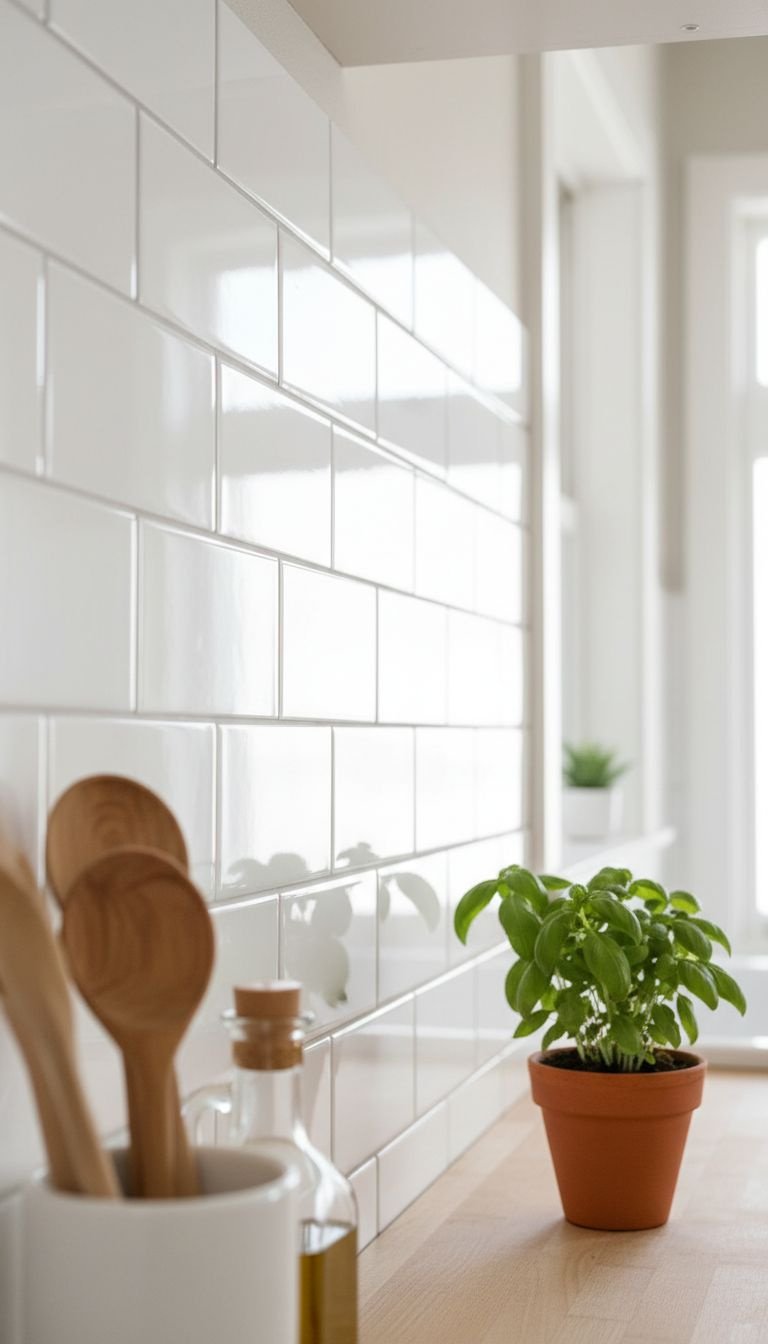
Pin this easy kitchen upgrade for later!
An old, stained backsplash can make an entire kitchen feel grimy. A temporary backsplash using modern peel-and-stick tiles is the perfect DIY solution. These vinyl tiles come in endless styles, from classic subway to intricate mosaics, and are designed to be heat and water-resistant, making them perfect for behind the stove and sink. Best of all? There’s no grout and no mess.
Materials Needed:
- Peel-and-stick tile sheets (choose a style that is heat and humidity resistant)
- Measuring tape
- Level
- Sharp craft knife or utility knife
- Self-healing cutting mat
- Degreasing cleaner (like TSP substitute) and a clean cloth
Step-by-Step Directions:
- Thoroughly clean your existing backsplash or wall with the degreaser to remove any grease. Let it dry completely.
- Measure the height and width of the area you want to cover.
- Plan your layout. Start from one corner, using the level to ensure your first sheet is perfectly straight.
- Peel the backing off your first tile sheet and carefully press it onto the wall, smoothing it out from the center to the edges.
- For the next sheet, overlap the “grout” lines as instructed by the manufacturer to create a seamless look.
- Use the craft knife and cutting mat to trim tiles to fit around outlets and at the end of rows.
Pro-Tip: Before removing the tiles when you move out, gently warm them with a hairdryer. This softens the adhesive and helps them peel off cleanly without residue.
2. Cover Dated Countertops with Realistic Contact Paper
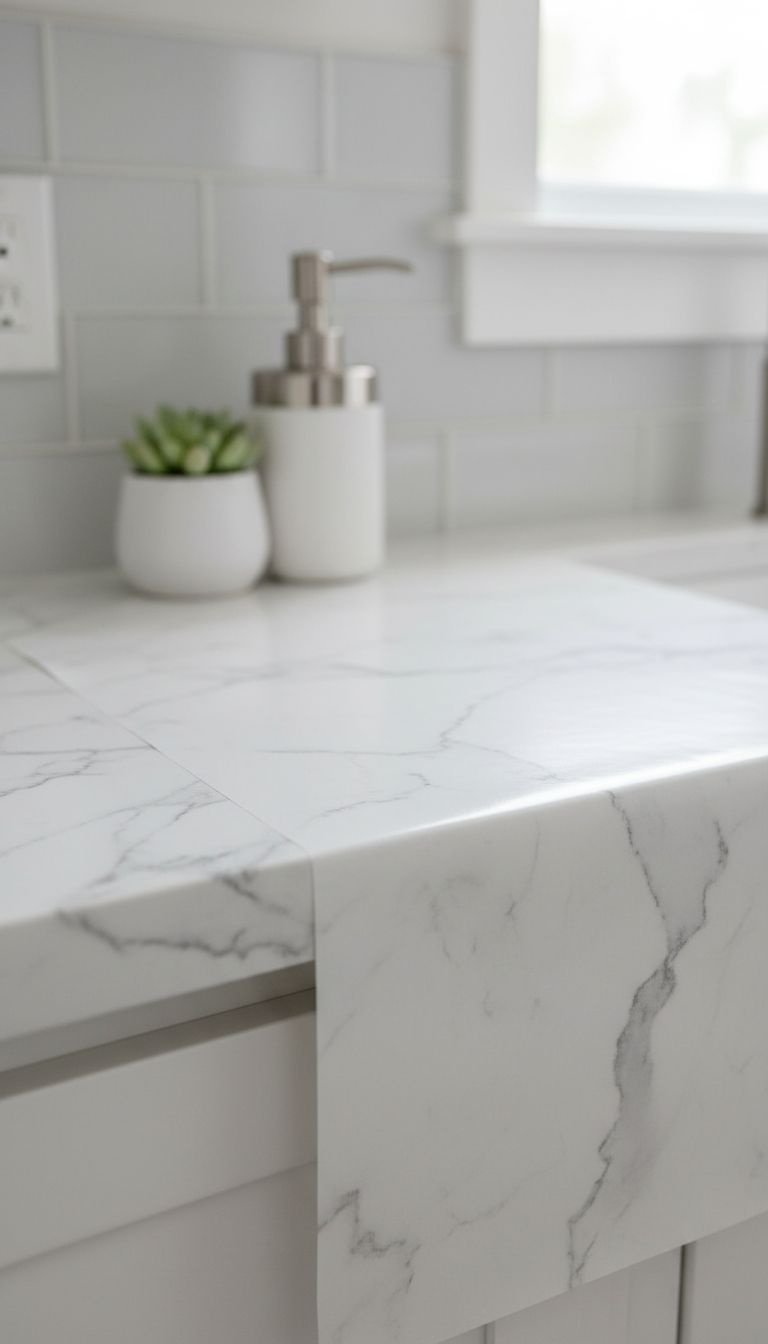
Save this genius hack for ugly countertops!
Dated laminate countertops are a common pain point in rental kitchens. Instead of living with them, cover them! High-quality vinyl contact paper offers a durable, waterproof, and completely removable temporary countertop fix. With hyper-realistic patterns like marble, concrete, and butcher block available, you can get a high-end look for a fraction of the cost of a real renovation.
Materials Needed:
- High-quality, thick vinyl contact paper (look for waterproof and durable options)
- Measuring tape
- Squeegee or a credit card
- Sharp craft knife with a fresh blade
- Hairdryer
- All-purpose cleaner
Step-by-Step Directions:
- Clean your countertops thoroughly and allow them to dry. Any speck of dust will show as a bump.
- Measure your counter and cut the contact paper, leaving at least 4 inches of overhang on all sides.
- Starting at one end, peel back about 6 inches of the paper backing.
- Carefully align the paper with the back edge of the counter and press it down.
- Slowly pull off the backing with one hand while using the squeegee with the other to smooth the paper and push out air bubbles. Work in small sections.
- For corners and edges, use the hairdryer to gently heat the vinyl, making it more pliable to wrap smoothly.
- Use the craft knife to trim the excess paper for a clean finish.
Lesson Learned: Overlap seams by about 1/4 inch if you need multiple pieces, and try to align the pattern so the seam is less noticeable.
3. Add Instant Ambiance with Under-Cabinet Lighting
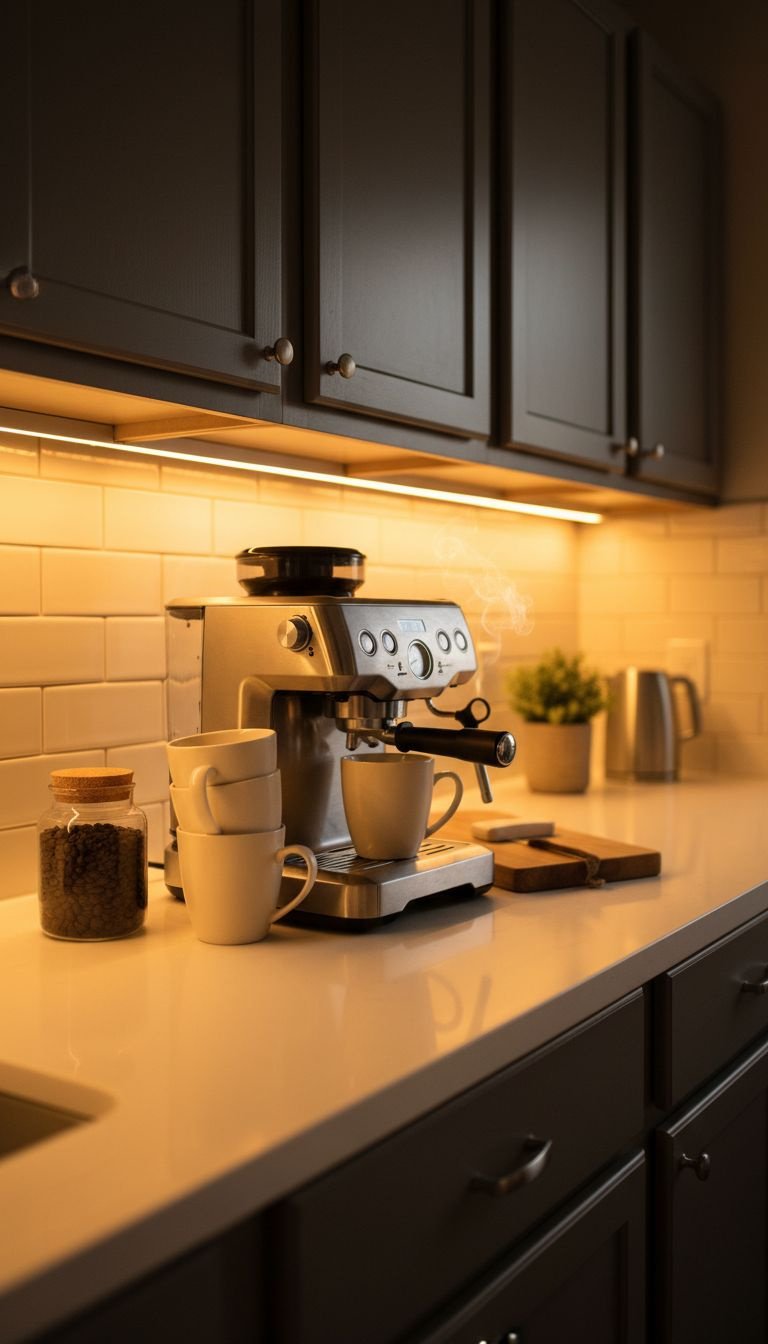
Pin this simple trick to brighten any kitchen!
Rental kitchens are notorious for having a single, harsh overhead light that casts shadows on your workspace. Adding under-cabinet task lighting is a game-changer. It not only makes food prep easier and safer but also adds a layer of warm, ambient light that makes the entire kitchen feel more expensive and inviting. No wiring is needed with modern battery-powered or plug-in LED options.
Materials Needed:
- A set of battery-powered LED puck lights or a rechargeable/plug-in LED light bar kit
- Rubbing alcohol and a cloth
- Measuring tape
Step-by-Step Directions:
- Decide on the placement for your lights. A good rule of thumb is to center them front-to-back under the cabinet, placing one light every 18-24 inches for even illumination.
- Use the rubbing alcohol to clean the surface where you’ll be sticking the lights. This ensures a strong bond.
- For puck lights, simply peel the adhesive backing and press each light firmly in place for 30 seconds.
- For light strips, peel the backing and apply the strip along the length of the cabinet. Use the included clips for extra security if provided.
- If using a plug-in model, neatly run the cord to the nearest outlet, using small, removable cord clips to hide it.
Pro-Tip: Look for lighting kits that come with a remote control or are motion-activated. It adds a touch of luxury and convenience.
4. Create More Counter Space with a Rolling Kitchen Cart
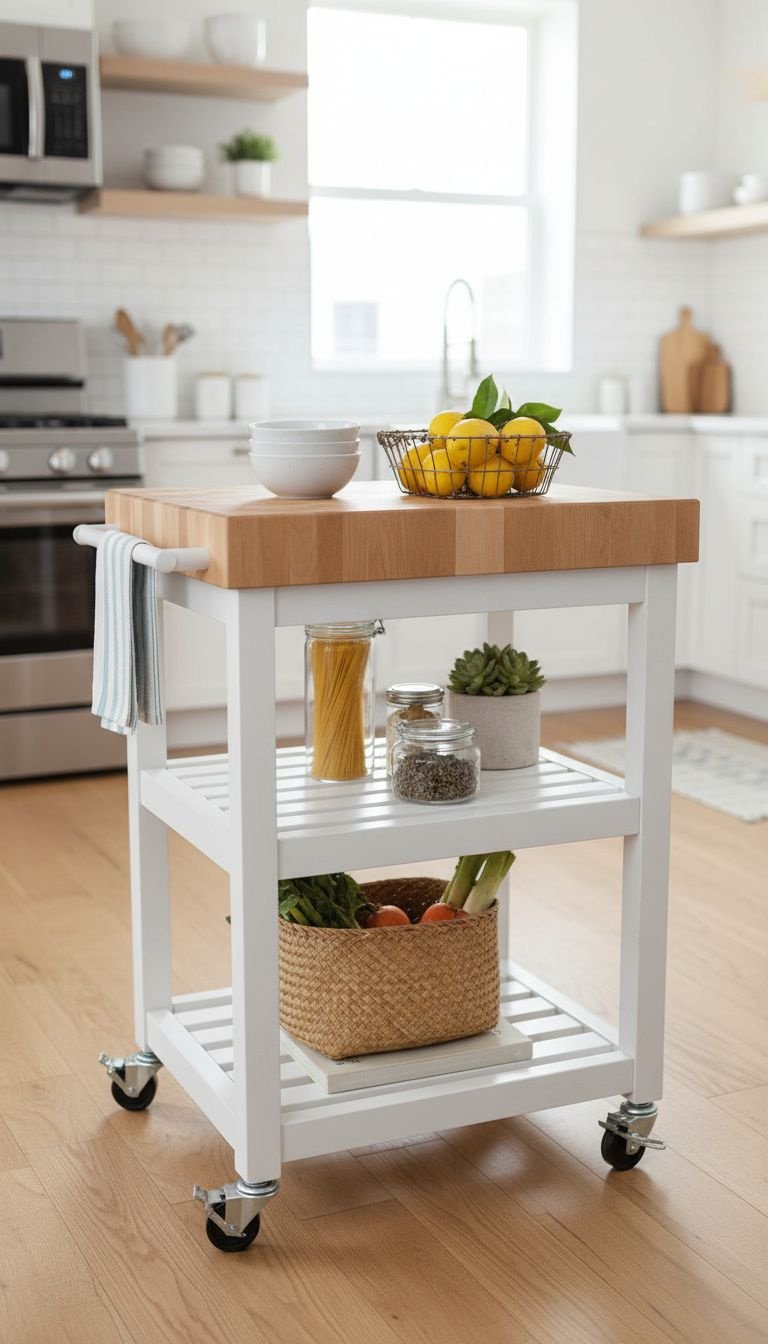
Need more space? Save this kitchen cart idea!
The number one complaint in small kitchens? No counter space. A rolling kitchen cart is the ultimate non-permanent solution, offering a multi-tier combo of extra prep space, much-needed storage, and a stylish focal point. It’s a freestanding piece of furniture, so it requires zero installation and can move with you to your next home.
What You Need (How to Choose):
- Measurements: Before you buy, measure the floor space where you plan to put the cart. Ensure there’s enough room to walk around it comfortably.
- Height: Choose a cart that is “counter-height” (around 36 inches) if you want it to function as a seamless extension of your prep space.
- Material: A butcher block top is great for food prep, while stainless steel is durable and easy to clean.
- Features: Look for features like locking wheels for stability, a towel bar, and a mix of shelves and drawers for versatile storage.
What To Do (How to Style):
- Top Shelf: Keep this surface clear for active food prep, or use it to create a dedicated station (like a coffee bar) with a nice tray.
- Middle Shelf: Use this for frequently used items you want to look good. Think a stack of matching bowls, a wire basket for produce, or your prettiest mixing bowls.
- Bottom Shelf: This is ideal for bulkier items like a stand mixer, a stack of pans, or large canisters for flour and sugar.
- Towel Bar: Always have a stylish tea towel hanging from the handle. It’s functional and adds a soft, homey touch.
Pro-Tip: Choose a cart that stylistically matches your desired kitchen aesthetic. A stainless steel cart feels modern, while one with a wood top and a painted base can feel more farmhouse or traditional.
5. Use Your Fridge for Vertical Spice & Knife Storage

Save this zero-drilling storage hack!
Your countertops are prime real estate. Stop letting clutter take over by looking up—specifically, at the side of your refrigerator. This often-ignored vertical surface is a magnetic goldmine for storage. Strong magnetic spice racks, knife strips, and paper towel holders can move bulky items off your counter and into a tidy, accessible spot. It’s the ultimate space-saving solution for small kitchen storage problems.
Materials Needed:
- A strong magnetic spice rack (check reviews for magnet strength)
- A magnetic knife strip or magnetic paper towel holder
- Optional: Uniform spice jars and a label maker for a cohesive look
Step-by-Step Directions:
- First, confirm the side of your refrigerator is magnetic (most are, but some high-end models have non-magnetic panels).
- Decant your most-used spices into the uniform jars and label them. This is optional but creates a huge visual impact.
- Simply attach the magnetic spice rack to the side of the fridge. Arrange your spice jars neatly.
- Attach the magnetic knife strip below or next to the spice rack. Carefully place your knives on the strip, ensuring they are secure.
- You can also add a magnetic paper towel holder to free up even more counter space.
Pro-Tip: Place the items you use most often at the most accessible height. Knives should be placed high enough to be out of reach of children.
6. Swap Out Dated Cabinet Hardware (And Save the Originals!)
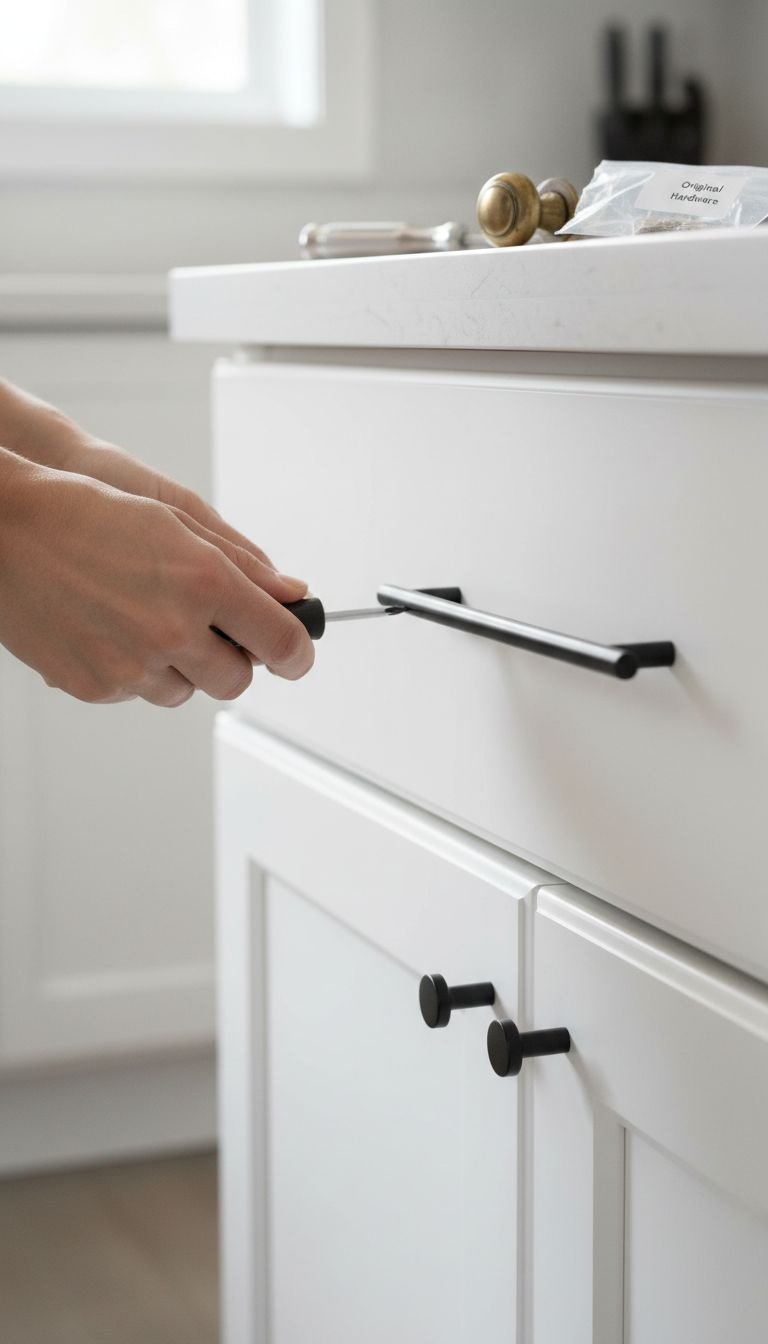
Pin this 1-hour kitchen makeover idea!
Never underestimate the power of hardware. Swapping out dated, cheap-looking cabinet knobs and pulls for something more modern and stylish is one of the easiest, highest-impact upgrades you can make. It’s a landlord-approved kitchen upgrade that takes less than an hour but can make your entire kitchen look more intentional and customized.
Materials Needed:
- New cabinet knobs or pulls
- A screwdriver (both Phillips and flat-head)
- A small plastic bag and a marker
- A measuring tape (if you have pulls)
Step-by-Step Directions:
- The Golden Rule: Label the plastic bag “Original Kitchen Hardware” and place it somewhere safe. You MUST put the old hardware back on before you move out.
- Unscrew one of your current knobs or pulls from the inside of the cabinet door.
- For pulls: Measure the distance between the center of the two screw holes. This is your “center-to-center” measurement, and you must buy new pulls with the exact same measurement.
- For knobs: This is easy – you just need to buy new knobs that use a single screw.
- Take your new hardware and simply screw it into the existing holes.
- Repeat for all cabinets and drawers. Place every single old knob/pull and screw into your labeled bag.
Lesson Learned: Don’t throw away any of the original screws! Sometimes new hardware comes with screws that are too long or short for your specific cabinets, and you’ll need the old ones.
7. Hide an Ugly Floor with a Stylish, Washable Runner

Save this idea for covering dated kitchen floors!
Cracked linoleum or dated tiles can be an eyesore. A beautiful kitchen rug is the perfect solution to hide an ugly kitchen floor. For long, narrow galley kitchens, a runner adds a pop of color, pattern, and texture, instantly making the space feel cozier and more stylish. The key is to choose one that is explicitly machine-washable for easy cleanup of inevitable kitchen spills.
What You Need (How to Choose):
- Washability: This is non-negotiable for a kitchen. Look for rugs explicitly labeled as machine-washable.
- Material: Low-pile cotton or synthetic materials like polypropylene are durable and easy to clean. Avoid high-pile rugs that trap crumbs.
- Size: For a galley kitchen, a long runner (e.g., 2.5′ x 7′) is perfect. Measure your floor space to ensure a good fit, leaving a few inches of floor visible on all sides.
- A Non-Slip Pad: Even if the rug has a non-slip backing, a separate high-quality rug pad is essential for safety to prevent any slipping on a smooth kitchen floor.
What To Do (Placement & Care):
- Clean your kitchen floor thoroughly before laying down the rug.
- Place the non-slip rug pad down first.
- Unroll your runner on top of the pad, centering it in the main walkway of your kitchen, typically in front of the sink and stove area.
- Smooth out any wrinkles.
- For care, shake the rug out weekly and follow the manufacturer’s instructions for machine washing when spills occur.
Pro-Tip: A rug with a busy pattern is excellent at hiding minor crumbs and stains between washes, making it a practical choice for a high-traffic kitchen.
8. Hang Utensils and Mugs with a Tension Rod

No drilling allowed? Pin this genius storage idea!
When you have limited cabinet space and a strict no-drilling policy, a simple tension rod is your secret weapon. By wedging a heavy-duty rod between a cabinet and a wall or inside a window frame, you create an instant hanging rail for utensils, mugs, and more using S-hooks. This clever kitchen utensil organization hack gets items out of stuffed drawers and turns them into a functional display.
Materials Needed:
- A heavy-duty tension rod (like those used for shower curtains, but smaller)
- A pack of S-hooks
- A measuring tape
Step-by-Step Directions:
- Identify a suitable spot for the rod. The best places are between a cabinet and a wall, between two cabinets, or inside a deep window frame.
- Measure the width of the space you chose. Purchase a tension rod that can adjust to that specific width.
- Slide your S-hooks onto the rod before you install it.
- Following the package directions, twist the rod to extend it until it fits snugly and securely in your chosen space. Ensure it’s level.
- Hang your most-used utensils, coffee mugs by their handles, or even a small wire basket for sponges from the S-hooks.
Pro-Tip: You can also use a tension rod vertically inside a deep cabinet to create dividers for baking sheets and cutting boards.
9. Create a Stunning Accent Wall with Removable Wallpaper
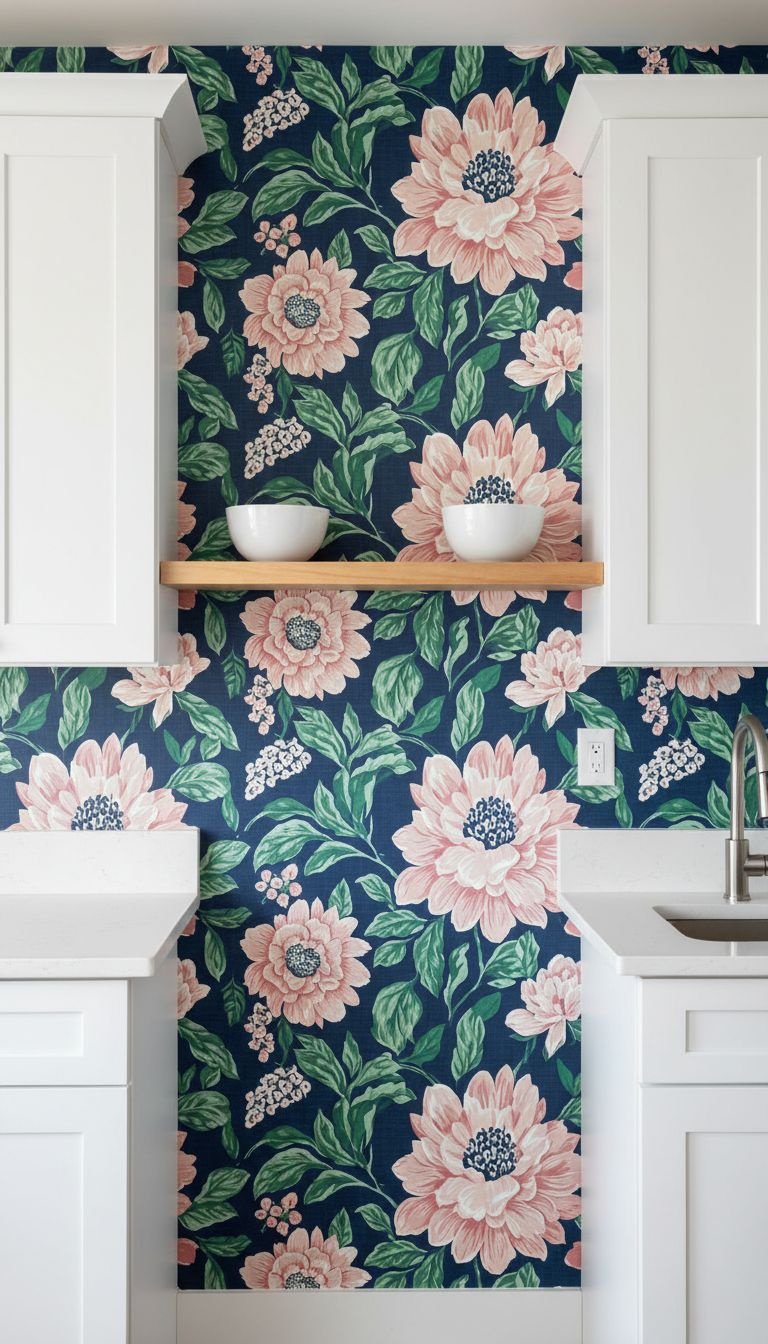
Save this bold idea for a boring kitchen!
Is your kitchen a sea of boring beige or sterile white? A temporary accent wall is the ultimate fix for adding a major dose of personality. Renter-friendly peel-and-stick wallpaper comes in thousands of patterns, from bold florals to subtle geometrics. Covering just one small wall can serve as a stunning focal point, making the entire kitchen feel custom-designed and full of life.
Materials Needed:
- Rolls of high-quality peel-and-stick wallpaper (measure your wall and buy 10% extra for mistakes)
- A level
- A wallpaper smoothing tool or squeegee
- A sharp craft knife
- A measuring tape
Step-by-Step Directions:
- Choose a small, simple wall to be your accent wall. A wall without too many windows or outlets is easiest for beginners.
- Clean the wall thoroughly and let it dry.
- Measure the height of your wall and cut your first strip of wallpaper, leaving an extra inch or two at the top and bottom.
- Starting from a corner, use your level to draw a faint, straight vertical line to guide your first piece.
- Peel about a foot of the backing away from the top of the strip and align it with your guide line, letting the extra inch overhang at the ceiling.
- Working from the top down, use your smoothing tool to press the wallpaper to the wall, pushing out air bubbles as you go.
- For the next strip, carefully align the pattern with the first piece before applying it. The pattern match is crucial for a professional look.
- Once all strips are up, use the craft knife to trim the excess at the ceiling and baseboard.
Pro-Tip: If you have textured walls, this may not work well. Removable wallpaper needs a smooth surface to adhere properly and remove cleanly.
Key Takeaways: Your Quick Guide to a Landlord-Approved Kitchen Makeover
- Focus on Surfaces: The biggest visual impact comes from temporary coverings. Use peel-and-stick products for backsplashes, floors, and countertops to hide dated finishes.
- Go Vertical for Storage: Get clutter off your counters by using walls and the side of your fridge with magnetic racks, tension rods, and freestanding shelves to maximize your space.
- Layer Your Lighting: Don’t rely on the harsh overhead light. Add easy-to-install under-cabinet lighting to create a warm, functional workspace and a cozy ambiance.
- Think Reversible: Every change you make, from swapping hardware to adding a rug, should be 100% reversible. Always save the original pieces in a labeled bag!
- Accessorize with Intention: Use textiles, plants, and art to add personality. These small touches make the biggest difference in making a rental space feel like your own.
People Also Ask About Decorating a Rental Kitchen
What is the cheapest way to update a rental kitchen?
The cheapest way to update a rental kitchen is by focusing on small, high-impact changes. Start by thoroughly decluttering and deep cleaning. Then, swap out cabinet hardware (saving the originals), add a colorful and washable runner rug, and use magnetic organizers on your fridge. These changes cost very little but can dramatically refresh the space.
How can I cover my ugly kitchen cabinets in an apartment?
Use high-quality, removable contact paper or vinyl wrap to temporarily change the look of your cabinets. This is the best damage-free alternative to painting. Choose a durable, wipeable finish. Always clean the cabinet doors thoroughly first and apply the paper slowly with a squeegee to avoid bubbles. Remember to remove it carefully before you move out.
Is peel-and-stick backsplash really renter-friendly?
Yes, most quality peel-and-stick backsplashes are designed to be renter-friendly and removable. To ensure they don’t damage the wall, choose a reputable brand, apply it to a clean, smooth surface, and avoid installing it on freshly painted walls. When it’s time to remove it, gently warm the tiles with a hairdryer to soften the adhesive for a clean peel.
Final Thoughts
A rental kitchen doesn’t have to be a source of frustration. It can be a canvas for your creativity and a space you truly love spending time in. By using these clever, temporary, and budget-friendly ideas, you can solve common problems like limited storage and ugly surfaces while injecting your own personal style into the heart of your home.
You don’t have to wait for your ‘forever home’ to have a kitchen that inspires you. Start with one of these weekend projects and see what a difference it makes! Which one of these ideas are you most excited to try first? Let me know in the comments below
Last update on 2025-11-14 at 23:08 / Affiliate links / Images from Amazon Product Advertising API
